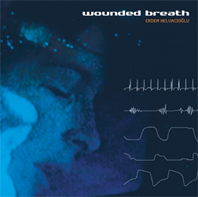: erdem helvacioglu
Aucourant, AUREC, 0899-1
http://www.aucourantrecords.com
 Turkish musician Erdem Helvacioglu is best known for his work with electric guitar and computer processing, drawing favourable comparisons with guitar/laptop artist Christian Fennesz (although Helvacioglu offers a significantly more polite if somewhat florid version of even Fennesz’s most accessible music). However with his latest release, Wounded Breath, Helvacioglu seems largely to have eschewed the guitar and instead produced an album of electroacoustic compositions.
Turkish musician Erdem Helvacioglu is best known for his work with electric guitar and computer processing, drawing favourable comparisons with guitar/laptop artist Christian Fennesz (although Helvacioglu offers a significantly more polite if somewhat florid version of even Fennesz’s most accessible music). However with his latest release, Wounded Breath, Helvacioglu seems largely to have eschewed the guitar and instead produced an album of electroacoustic compositions.
After several listens the overall impression is of digital reverberation. This is not to say that these compositions are geared towards any discrete exploration of the parameters or expanses of synthetic space creation, nor that they are pursuing reverberation as a means of sound production in and of itself. Instead there is the sense that echo, reverb and digitally induced spaciousness has been injudiciously applied to just about every sound in these compositions. While this may lend the album superficial production slickness, it has the effect of homogenising not only the sounds used to construct the works—which have effectively had any sharp corners or angles sheared away with the sonic equivalent of a sander and buffer—but the compositions themselves. Perhaps Helvacioglu’s work in film soundtracks might explain this overactive fascination with digital reverberation. However, even the sonic codes of mainstream action cinema don’t require quite this degree of synthesised echo.
It may seem churlish to chastise an artist for the overuse of a particular effect or form of signal processing. However, any argument that could be constructed in relation to other musical genres positing a division between electronic effects and an artist’s aesthetics is hardly applicable to electroacoustic or electronic music. An artist’s choice of the processes for modifying sounds is no more or less significant than their selection of sounds upon which those processes are deployed, if indeed these two features can be considered separately. A given sound, once affected or processed, is not only a new sound, it is the sound as heard in the work, and this is what listeners encounter. In some cases, processing is not an afterthought so much as the stimulus for the work. Therefore, in electroacoustic compositions such as these, processing must be considered not only as integral to the compositions, but a serious indicator of the aesthetics involved.
Unfortunately, listening beneath the echo isn’t a particularly rewarding experience. While the reverberation in these compositions might promise a series of potentially sensational spaces, they are ultimately rather drably adorned, or alternately filled with little of interest. Many of the sounds used here—despite how they may have been generated—will be familiar to even casual listeners of electronic music produced in the last 50 or so years: bleeps, bubbling yibbles, deep winding drones, shuffling white noise and so on. Structurally the works offer few surprises, following a simple (and well-worn) formula of peak and trough. This gives all the works a kind of unit structure that becomes maddeningly predictable long before the CD is through. Added to this is a reliance upon the cavalcade of affective clichés that echo is so often used to induce. Yes, the various reverberations all sound ‘great’ and fulfil all the related adjectives—‘rich’, ‘deep’, ‘cavernous’, ‘spacey’, ‘watery’, ‘cold’, ‘scary’ and so on—but regrettably it doesn’t leave the listener with anything much of interest to engage with. Swamped in reverb the sounds don’t really get much of a chance to speak for themselves, and, as a result, in a slightly strange way, neither does the artist.
Peter Blamey






